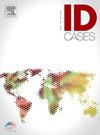A case of ehrlichiosis with meningoencephalitis and multi-organ failure
IF 1
Q4 INFECTIOUS DISEASES
引用次数: 0
Abstract
Ehrlichiosis is a bacterial illness primarily transmitted through the bite of an infected lone star tick. According to the Centers for Disease Control (CDC), the United States is experiencing a rising number of reported cases, with a case fatality rate of approximately 1 %. The disease typically manifests as a non-specific flu-like illness, however in rare cases, it can progress to severe disease with multi-organ failure and mortality. We present a case of a 70-year-old male who was transferred to the intensive care unit of our facility for the management of septic shock associated with multi-organ failure. He had a history of recent exposure to multiple tick-bites while performing yard work. He was diagnosed with Ehrlichiosis based on positive serum IgM and IgG antibodies against Ehrlichia chaffeenesis. A lumbar puncture also confirmed meningoencephalitis. The patient completed intravenous Doxycycline treatment for 14 days, resulting in clinical improvement. Identifying Ehrlichia as the causal organism for meningoencephalitis and severe disease is challenging due to its low prevalence. This case emphasizes the significance of promptly suspecting and identifying ehrlichiosis in patients who exhibit meningoencephalitis symptoms or end-organ failure and have a recent history of engaging in outdoor activities with a risk of exposure to ticks, especially in endemic regions. It also signifies the importance of empirically treating with doxycycline even before its diagnosis as delay in providing doxycycline can significantly lead to more complications compared with patients who receive it early on during hospital admission.
埃立克体病合并脑膜脑炎及多器官功能衰竭1例
埃利希体病是一种细菌性疾病,主要通过被感染的孤星蜱叮咬传播。根据美国疾病控制中心(CDC)的数据,美国报告的病例数量正在上升,病死率约为1 %。该病通常表现为非特异性流感样疾病,但在极少数情况下,可发展为多器官衰竭和死亡的严重疾病。我们提出一个70岁的男性谁被转移到我们的设施的重症监护病房管理脓毒性休克相关的多器官功能衰竭。他最近在院子里干活时曾多次被蜱虫叮咬。根据血清抗沙菲埃立体IgM和IgG抗体阳性,诊断为埃立体病。腰椎穿刺也证实脑膜脑炎。患者完成多西环素静脉治疗14天,临床好转。由于其低患病率,确定埃利希体作为脑膜脑炎和严重疾病的致病生物具有挑战性。本病例强调,对于出现脑膜脑炎症状或终末器官衰竭并近期有接触蜱虫风险的户外活动史的患者,特别是在流行地区,应及时怀疑和识别埃利希体病。这也表明,即使在诊断之前,也应经验性地给予强力霉素治疗,因为与住院期间早期接受强力霉素治疗的患者相比,延迟提供强力霉素可显著导致更多并发症。
本文章由计算机程序翻译,如有差异,请以英文原文为准。
求助全文
约1分钟内获得全文
求助全文

 求助内容:
求助内容: 应助结果提醒方式:
应助结果提醒方式:


